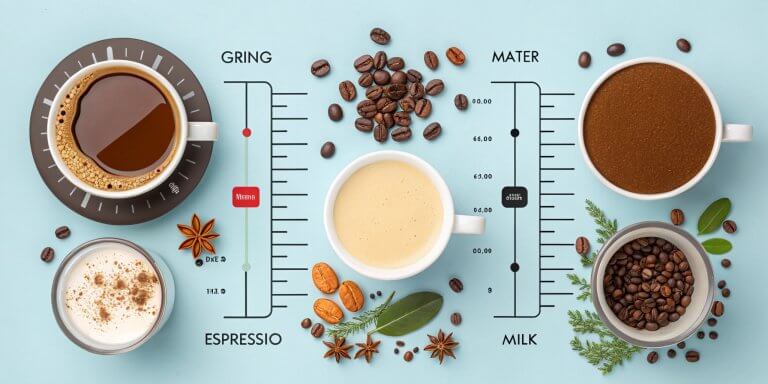
Hello, coffee enthusiast! Ever been stumped by a coffee menu? Lattes, cappuccinos, macchiatos—the list goes on, and you might wonder, “What’s the real difference?” You’re not alone! The world of espresso drinks is vast, with a diverse array of options that can feel overwhelming.
Understanding the different types of espresso drinks can genuinely elevate your coffee experience. It opens the door to exploring new flavors and discovering your ideal cup. In this guide, we’ll explore the most popular types of espresso drinks, from a simple shot of espresso to complex and delicious creations. You’ll learn about what goes into them, how they’re made, and their origin stories. Prepare to become an espresso aficionado!
What is Espresso?
Espresso is a concentrated coffee beverage. It’s not just a type of bean but a specific brewing process. This process involves forcing hot water through finely ground coffee beans under high pressure, typically around 9 bars, for a short period, usually 25-30 seconds. The result is a small but potent shot of coffee with a unique flavor profile.
- The espresso has three parts:
- Crema, the light brown foam on top, holds the aromatics.
- The caramel-colored section lies between the crema and the heart.
- Heart, the dark brown section at the bottom, carries bitter notes.
Espresso differs from regular coffee in several ways:
- Flavor: Espresso has a more intense flavor due to the brewing process.
- Caffeine Content: Espresso contains more caffeine per ounce, though a serving of regular coffee typically has more caffeine overall. A single shot of espresso contains about 64 milligrams of caffeine.
- Preparation: Espresso uses a finer grind and a pressurized brewing method.
When it comes to the beans themselves, an espresso bean is simply a coffee bean that is roasted longer and darker. This brings out oils in the bean that work well with a fine espresso grind.
Essential Espresso Drinks
Let’s dive into the heart of espresso: the essential drinks that form the foundation of every coffee shop menu. These are the building blocks upon which countless other creations are based.
- Single Espresso
Think of this as the purest expression of espresso. It’s a single, concentrated shot, typically around 1 oz. A single-shot filter is used with about six to eight grams of finely ground coffee to make one. The flavor profile is intense and concentrated, delivering a powerful punch in a small package. - Doppio (Double Espresso)
Need an extra kick? The doppio, meaning “double” in Italian, is your answer. It’s simply a double shot of espresso, or 2 oz. Preparation involves using a double-shot filter with a larger amount of coffee grounds. Expect a more robust and concentrated flavor profile than its single counterpart. - Ristretto (Restricted)
The ristretto offers a unique twist on the espresso experience. Ristretto means “restricted” in Italian. It is a short shot of espresso made with less water. Finer coffee grounds and half the usual amount of water are used, resulting in a more concentrated, sweeter, and smoother flavor than regular espresso. Many people enjoy ristretto because it contains fewer compounds released from the coffee beans, making it softer and sweeter than espresso. - Lungo (Long)
The ” long ” lungo in Italian is essentially an espresso shot pulled with more water. To prepare it, twice as much water is run through the same amount of coffee grounds. This yields a flavor profile with more caffeine and a more bitter taste. Overall, Lungo is an excellent choice for a firmer yet smoother cup. Because of its higher caffeine content and stronger flavor, you could consider it your go-to drink for waking up.
Mastering these essential types of espresso drinks is the first step to truly appreciating the vast world of coffee. Each offers a unique experience, and understanding their differences will allow you to explore and discover your perfect espresso match.
Espresso Drinks with Milk
Adding milk enhances many espresso drinks, creating various flavors and textures. Let’s explore some popular types of espresso drinks that incorporate milk, each offering a unique experience:
- Macchiato
The word “macchiato” means “stained” or “marked” in Italian, perfectly describing this drink. It consists of espresso “stained” or “marked” with a small amount of foamed milk. To prepare it, add a dollop of steamed milk and foam to a shot of espresso. The flavor profile is a strong coffee taste balanced by subtle sweetness from the milk. The drink’s simplicity allows you to appreciate the full strength of the espresso while still enjoying the added texture of milk foam. - Latte
A latte is one of the most popular types of espresso drinks. It features espresso with steamed milk and a thin layer of foam. Combine espresso with steamed milk, topped with micro-foam, and add flavored syrups for a sweet twist. The flavor profile is creamy and smooth, with a mild coffee flavor. These delicious drinks are often served in taller glasses than other espresso-based drinks, allowing the layers of liquid and foam to be visible. - Cappuccino
The cappuccino, a classic Italian coffee drink, is a testament to the art of balance. It consists of equal parts espresso, steamed milk, and milk foam, creating a harmonious blend of flavors. When made correctly, a cappuccino should have a full-bodied flavour, balancing the bitterness of espresso and the sweetness of the milk, ensuring a satisfying and comforting coffee experience. - Flat White
The flat white is similar to a latte but with a stronger espresso flavor. It consists of espresso with steamed milk, but little to no foam. It is prepared similarly to a latte but with a higher coffee-to-milk ratio and a velvety texture. - Cortado
A Cortado is a Spanish espresso drink made with equal parts espresso and steamed milk. To prepare it, combine equal amounts of espresso and steamed milk. The flavor profile is balanced, with a smooth texture and minimal foam. It’s ideal for those who want a rich but mellow coffee experience. - Breve
The breve is a decadent option for those who want an indulgent and sugar-free coffee experience. It’s an espresso-based drink made with steamed half-and-half instead of milk. To prepare it, combine espresso with steamed half-and-half. This creates a creamier, fluffier texture than a traditional latte. - Latte Macchiato
Ideal for those who love a creamy espresso beverage, a latte macchiato consists primarily of steamed milk with a small amount of espresso. To prepare it, pour steamed milk into a glass and add a shot of espresso on top. The flavor profile is creamy, with a distinct layering of milk and espresso.
These espresso drinks, each with its unique preparation and flavor profile, offer a delightful range of options for coffee lovers. Whether you prefer a bold, balanced, or creamy beverage, there’s an espresso drink with milk to suit every palate.
Other Espresso-Based Drinks
Beyond the essential espresso drinks and those combined with milk, there’s a wide range of other espresso-based beverages to explore. These drinks offer unique flavor combinations and cater to different preferences:
- Americano
An Americano is espresso diluted with hot water. To prepare, add hot water to a single or double shot of espresso. The resulting flavor profile is milder than regular espresso, similar to black coffee. It’s a nice option if you want espresso’s bold, complex flavor but the volume of a drip coffee. - Mocha
A mocha is a sweet and indulgent treat that combines espresso with chocolate, steamed milk, and whipped cream. It is prepared by mixing espresso with chocolate syrup, adding steamed milk, and topping with whipped cream, which results in a sweet and chocolatey flavor profile. - Red Eye and Variations
The Red Eye and its variations answer those needing an extra caffeine boost. A Red Eye is coffee with a shot of espresso, while a Black Eye contains a double shot, and a Dripped Eye has a triple shot. To prepare, simply add espresso to a cup of brewed coffee. Expect a high caffeine content and intense flavor. - Espresso Con Panna
Espresso con panna offers a simple yet elegant combination: espresso topped with whipped cream. Add whipped cream to a single or double shot of espresso to make it. The flavor profile is rich and indulgent. - Affogato
An Affogato is more of a dessert than a drink, perfect for those who enjoy a sweet treat with coffee. It is made by pouring espresso over ice cream. Prepare by pouring an espresso over a vanilla ice cream or gelato scoop. The flavor profile is creamy sweetness with bold coffee.
Regional and Specialty Variations
Many regions have created their unique twists on espresso-based drinks, showcasing local flavors and traditions:
- Galão (Portugal)
This is a Portuguese drink consisting of one-quarter espresso and three-quarters milk foam. To make it, combine espresso with steamed milk in a tall glass. The resulting flavor profile is creamy and mild. The key difference between Galão and other coffee drinks is the ratio of milk to espresso. - Black Tie (Thailand)
A Black Tie combines a double shot of espresso with Thai tea. Prepare it by adding espresso to hot Thai tea, which results in a unique blend of coffee and tea. - Café Con Hielo (Spain)
In Spain, a popular choice is Café Con Hielo, which is strong espresso poured over ice. To prepare it, you simply pour strong espresso over ice. The flavor profile is bold and refreshing. - Cubano
The Cubano involves espresso brewed with sugar. To prepare it, brew espresso directly onto sugar and stir until dissolved. This results in a sweet and pungent flavor profile. - Espresso Romano
Espresso Romano is espresso served with a lemon slice. Serve espresso with a lemon slice on the side to prepare it. The flavor profile is enhanced coffee flavors with a citrusy note.
Making Espresso Drinks at Home
Creating your favorite espresso drinks at home can be a rewarding experience. Here’s what you need to know to get started:
- Equipment Needed
To make espresso drinks at home, you’ll need specific equipment such as an espresso machine, grinder, tamper, and milk frother. - Step-by-Step Instructions
- Grind the beans to a fine consistency.
- Pack the portafilter evenly with the ground coffee.
- Pull the shot for 20-30 seconds.
- Steam the milk until it reaches a velvety texture.
- Combine ingredients according to the desired drink.
- Tips for Success
- Use fresh, high-quality beans for the best flavor.
- Experiment with different milk alternatives to find your preference.
- Adjust ratios to suit your taste.
- Espresso without a Machine
If you don’t have an espresso machine, you can still make a version of espresso using alternative methods and equipment like a Moka pot, AeroPress, or French press. However, note that the result might differ from that of espresso made with a professional machine. With these alternative methods, it’s important to fine-tune your process by adjusting the coffee grind size, water temperature, or brewing time to get your desired result.
Health and Nutritional Aspects
When considering espresso drinks, it’s essential to be aware of their health and nutritional aspects:
- Caffeine Content: Different espresso drinks contain varying levels of caffeine. For example, a Red Eye has a higher caffeine content because espresso is added to coffee.
- Health Benefits and Risks: Caffeine consumption has potential benefits and risks. Added ingredients like sugar and syrups can impact the nutritional value of these drinks.
- Non-Dairy Options: Non-dairy milk alternatives, like oat milk, offer lactose-free options for those who avoid dairy.
Conclusion
From essential espresso to regional variations and dessert-like options, espresso drinks are available to suit every taste. Readers are encouraged to explore and try new espresso drinks to discover their favorites.

